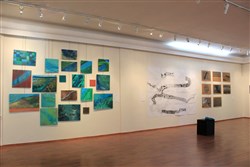BY TASNEEM AL-GHAMDI (COMD/IV)
 An archaeological workshop, “Anatolian Rivers Between East and West: Axes and Frontiers,” was held jointly by the Faculty of Art, Design and Architecture and the Faculty of Humanities and Letters on November 18. Focusing on the rivers of Anatolia in their dual roles as natural boundaries and facilitators of settlement and communication, the workshop was the first in a series of three such events designed to bring together specialists in diverse fields to discuss this topic. Along with Bilkent University, Labex TransferS (École Normale Supérieure, Paris) is providing support for the series. In conjunction with the workshop, students in the Departments of Fine Arts and Graphic Arts prepared an exhibition titled “Along the River.”
An archaeological workshop, “Anatolian Rivers Between East and West: Axes and Frontiers,” was held jointly by the Faculty of Art, Design and Architecture and the Faculty of Humanities and Letters on November 18. Focusing on the rivers of Anatolia in their dual roles as natural boundaries and facilitators of settlement and communication, the workshop was the first in a series of three such events designed to bring together specialists in diverse fields to discuss this topic. Along with Bilkent University, Labex TransferS (École Normale Supérieure, Paris) is providing support for the series. In conjunction with the workshop, students in the Departments of Fine Arts and Graphic Arts prepared an exhibition titled “Along the River.”
The organizers of the workshop provided this summary of the topic’s significance in the study of Anatolia’s history and prehistory: “From the smallest streams to major rivers flowing into the seas, waterways have always determined the fate of Anatolia. Today, they are at the heart of debates on energy, agricultural and industrial policies, urban development and environmental protection in Turkey, and in neighboring countries of Europe and the Middle East. In the past, they represented habitation axes and routes for migration, trade and transit, as well as major borders of the Anatolian plateau.”
However, this aspect of the geographical, economic and cultural past of Anatolia has not yet received a great deal of attention. The workshop at Bilkent was thus the first of its kind, serving as a pilot to open up a new field of study for the scientific community. Prof. Dominique Kassab Tezgör from Bilkent University (FA and HART) served as a coordinator of the event, along with colleagues from three other institutions in two other countries: Asst. Research Prof. Anca Dan (École Normale Supérieure, CNRS, Paris) and Assoc. Prof. Stéphane Lebreton (University of Artois, Arras) from France; and Senior Researcher Nino Inaishvili (Institut Niko Berdzenishvili, Shota Rustaveli State University, Batumi) from Georgia.
to open up a new field of study for the scientific community. Prof. Dominique Kassab Tezgör from Bilkent University (FA and HART) served as a coordinator of the event, along with colleagues from three other institutions in two other countries: Asst. Research Prof. Anca Dan (École Normale Supérieure, CNRS, Paris) and Assoc. Prof. Stéphane Lebreton (University of Artois, Arras) from France; and Senior Researcher Nino Inaishvili (Institut Niko Berdzenishvili, Shota Rustaveli State University, Batumi) from Georgia.
Focusing on the connectivity of the rivers, the workshop offered an original approach by bringing together scholars in different fields—archaeologists, geographers, historians, geomorphologists and hydrologists—who study various periods, from the Neolithic to the Ottoman and beyond. Experts from Turkey, France, Japan, the US and Germany presented papers or served as moderators and panelists at workshop sessions.
During the lunch break between the morning and afternoon sessions, the student exhibition “Along the River” opened in the FADA Art Gallery. Under the guidance of instructors Agnieszka Srokosz, Ekin Kılıç Ezer, Beata Zalewska, Yves Gobart and Ahmet Özsalar, Fine Arts and Graphic Design students had created works based on the theme of rivers as sources of life and inspiration. Ms. Srokosz and Ms. Kılıç Ezer curated the exhibit.
 Finally, on the day following the workshop proper, participants visited the Japanese Institute of Anatolian Archaeology in Kaman (Kırşehir). There, Prof. Kimiyashi Matsumura guided them around the excavation site of Büklükale, where he is directing the work. The site, situated on a hill overlooking the Kızılırmak, provided an illustration of the points Prof. Matsumura had presented in his paper the day before. The group also visited the Kaman museum and archaeological center.
Finally, on the day following the workshop proper, participants visited the Japanese Institute of Anatolian Archaeology in Kaman (Kırşehir). There, Prof. Kimiyashi Matsumura guided them around the excavation site of Büklükale, where he is directing the work. The site, situated on a hill overlooking the Kızılırmak, provided an illustration of the points Prof. Matsumura had presented in his paper the day before. The group also visited the Kaman museum and archaeological center.
The remaining workshops in the series will take place in 2017. On May 4–7, Shota Rustaveli State University in Batumi will host the second workshop, which  will focus on exploitation of the economic resources of the areas along the rivers flowing between Europe and Asia.
will focus on exploitation of the economic resources of the areas along the rivers flowing between Europe and Asia.
Finally, on September 28–October 1, the third workshop will take place in Istanbul, at the French Institute for Anatolian Studies. It will examine the cultural aspects of the rivers, from the Meriç in the west to the Tigris in the east, and from the Don and Rioni in the north to the Nile to the south.
The papers from the three workshops will be published in a peer-reviewed publication.
